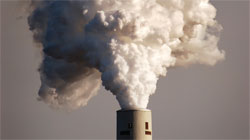Gina McCarthy, current U.S. EPA Administrator, released historic words this week in a long draft document about national power plant goals. How do they compare to the goals penned by Thomas Jefferson in a much shorter draft document, the Declaration of Independence? Let’s crunch some numbers to find out.

Despite the context of slavery during the time of Thomas Jefferson and his peers, the goals of equality and freedom set forth in the draft Declaration of Independence charted a new course for America that influenced the world. Likewise, given the context of the nation’s fossil-fuel history, McCarthy, on behalf of EPA and the current U.S. Administration, has released a draft proposed power plant rule that charts a new course for America that is likely to influence the world.
First let’s look at what many have been asking about the power plant rule – how much will it change the pace of global warming? Second, let’s compare the EPA proposed goal trend to the trend in recent years from bottom-up initiatives by states and leaders in communities across America to stem power plant carbon dioxide emissions (you may be surprised). Finally, let’s check the contrasts and parallels in history to see if this comparison between McCarthy and Jefferson is justified.
How much would the new EPA power plant rule change the pace of global warming?
An assessment of pledges that many countries have made to reduce heat-trapping emissions allows for a comparison of this new proposal from the EPA with commitments around the world.
As you can see from the historic and projected goals set forth, the new EPA proposal would take a step toward international pledges (see charts in terms of CO2 equivalent emissions per year and in terms of carbon intensity for U.S. energy). You will notice the proposed rule is a much less ambitious trend than the recent boost by local and state initiatives.
Recent UCS analysis suggests the historic carbon standard could cut power plant emissions in half. To help out, the advances in fuel economy standards should add another step. Still looking at the charts, one can see why administration official, John Podesta, has acknowledged that the U.S. has proposed a path that is perhaps closer to an increase of 3 degrees Celsius than 2 degrees Celsius for global average temperature.
Progress on emissions and an American history of ambitious goals
The good news is that this new rule tackles the the electricity sector, the largest source of U.S. emissions (see chart of emissions by sector). More importantly, the carbon emissions are increasingly decoupled from the growing U.S. economy (see U.S. Emissions per GDP trends).
These encouraging trends are all prior to the new EPA proposed power plant standards. History suggests that when America sets about achieving a goal, Americans have achieved goals that were unthinkable upon first utterance while others goals were delivered faster and beyond initial ambitions.
Thomas Jefferson, was a citizen scientist and a grand thinker about individual rights, freedom, and equality even as he and his peers partook in and lived in a time of great inequalities, including slavery.
This post is part of a series on the EPA Clean Power Plan.
Textbooks and current news cycles are full of laws and acts around the world that are making these ambitious goals part and parcel of many lands where people govern and struggle for broader application of the U.S. Declaration of Independence goals.
Similarly, initial proposals to limit “acid rain” or chemicals that create the so-called “ozone hole” set achievable goals that were far surpassed by ingenuity and trial and error in policymaking. This week is a historic game changer that has the wind of historic precedence to inspire the framework so the U.S. can once again far surpass these EPA goals.
You can help strengthen the goals by submitting comments on the new proposed EPA rule during the upcoming public comment period. Stay tuned!



